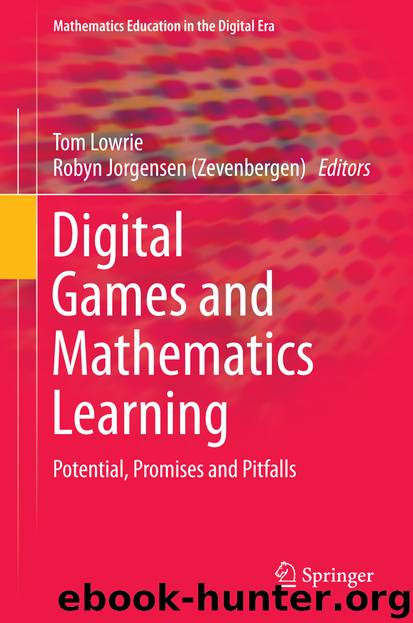Digital Games and Mathematics Learning by Tom Lowrie & Robyn Jorgensen (Zevenbergen)

Author:Tom Lowrie & Robyn Jorgensen (Zevenbergen)
Language: eng
Format: epub
Publisher: Springer Netherlands, Dordrecht
Yet we must not lose sight of Goldstone and Day’s (2012) trinity of the stance of the learner, the role of motivation, and the specific instructional techniques that can make learners better at transferring mathematical knowledge. In the next section, I will talk about the role of situated learning problem solving and the formation of attitudes, and we will see how a game can address all three. But before we do, it might help to describe one more game; one that we are currently developing. Its goal is to promote expert-like thinking in science measured, in part, by the ability of students to solve analog science problems, and to promote positive attitudes in girls regarding engineering science. The working title is Eco Adventure, and it takes place in a city where learners encounter three problems of increasing complexity, each of which forms one of the three levels in this game (L1–L3), in authentic ways (e.g., through the media, conversations, and observation). Using the SAPS model described in this chapter, learners solve these problems under the scaffolded guidance of a mentor. Through their interactions with people in the game, including a diverse group of scientists, local government officials, and community members, learners participate in authentic scientific processes while solving problems that deal with water, soil, and air impacting human, animal, and plant ecosystems. Learners set their own subgoals for play by earning badges, including “Green” badges (by choosing eco-friendly options), “Sleuth” badges (by minimizing the number of visits to key resources), and “Hero” badges (by promoting processes that maximally benefit people and animals). Players travel by clicking locations on the map and selecting the method of transport in order to interview people, conduct research, test solutions, or present findings to the elite Eco-Protector Scientists (EPS) group and to citizens. Our game also employs a variety of scaffolding strategies at key points in the problem-solving process using hints and prompts to get the learner to consider what they may be able to learn (their stance, or intentionality) from the current problem that could be helpful later (forward transfer) or how what they have learned might be applicable to a new problem (backwards transfer). The first problem provides the most scaffolding. Once learners solve this problem they encounter a more complex problem, which requires more from them, and which is accompanied by less scaffolding. The last problem requires learners to solve a more complex problem with multiple solutions, none of which is perfect. They receive almost no support along the way for this problem. Automatic, proximal measures such as deviation from the optimal solution path, elapsed time between key problem nodes, and patterns of responses to EPS questions are used to approximate measures of the learner’s current thinking and to trigger mentor intervention in science.
So there is evidence that digital games are a kind of problem-solving instruction themselves and therefore should be just as effective as other instructional modalities in supporting problem-solving instruction. As situated learning environments (e.g., we play a specific character in a setting driven by a consistent narrative), digital games should also promote transfer.
Download
This site does not store any files on its server. We only index and link to content provided by other sites. Please contact the content providers to delete copyright contents if any and email us, we'll remove relevant links or contents immediately.
| Arts & Humanities | Health |
| Language Arts | Library Skills |
| Mathematics | Reading & Phonics |
| Science & Technology | Social Studies |
The Art of Coaching Workbook by Elena Aguilar(48065)
Trainspotting by Irvine Welsh(20055)
Twilight of the Idols With the Antichrist and Ecce Homo by Friedrich Nietzsche(17705)
Fangirl by Rainbow Rowell(7834)
Periodization Training for Sports by Tudor Bompa(7328)
Change Your Questions, Change Your Life by Marilee Adams(6641)
This Is How You Lose Her by Junot Diaz(5772)
Grit by Angela Duckworth(4736)
Red Sparrow by Jason Matthews(4666)
Asking the Right Questions: A Guide to Critical Thinking by M. Neil Browne & Stuart M. Keeley(4574)
Paper Towns by Green John(4169)
Room 212 by Kate Stewart(4107)
Ken Follett - World without end by Ken Follett(3972)
The Sports Rules Book by Human Kinetics(3588)
Housekeeping by Marilynne Robinson(3401)
The Motorcycle Diaries by Ernesto Che Guevara(3332)
Introduction to Kinesiology by Shirl J. Hoffman(3300)
Exercise Technique Manual for Resistance Training by National Strength & Conditioning Association(3291)
Double Down (Diary of a Wimpy Kid Book 11) by Jeff Kinney(3272)
